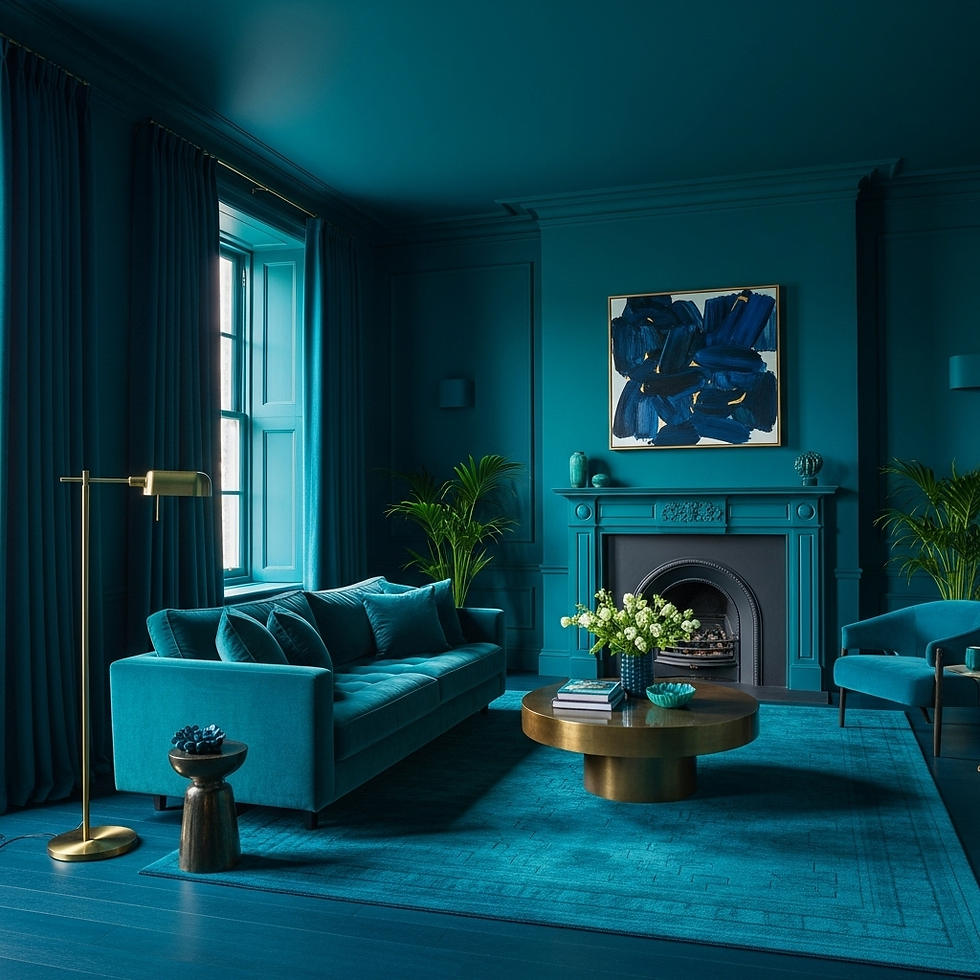Color Drenching: The 2025 Guide
- Tanu Mathur
- Sep 13
- 3 min read
How to envelop rooms in one hue for immersive, modern interiors

Introduction
Color drenching is reshaping interiors in 2025, enveloping walls, trim, ceilings, and furnishings in a single hue to create an immersive, cocooning atmosphere. This mood-forward approach delivers bold character with low visual noise, helping compact rooms feel calmer and more unified than contrasting schemes.
What is color drenching
Color drenching coats the room’s architectural envelope—walls, woodwork, doors, radiators, and the ceiling—in one color or closely related tones. By minimizing breaks between surfaces, edges soften and the eye travels smoothly, boosting cohesion and comfort compared to high-contrast palettes.

Why it’s trending now
Homeowners and designers are moving away from stark minimalism toward emotive, personal spaces, and drenching offers a cohesive way to achieve depth and mood. The ceiling is now treated as the “fifth wall,” abandoning default white in favor of harmonized tones that complete the envelope and elevate architectural detail.
2025 trends to watch
Double drenching: Two related hues flood a space—one for walls, another for trim or ceiling—to add nuance without breaking unity.
Pattern drenching: One motif (stripes, florals, scenic papers) repeated across walls and key upholstery for maximalist cohesion.
Statement ceilings: Saturated ceilings that match or deepen wall color to complete the envelope and highlight moldings.
Rich tinted darks: Blue‑violet and moody mid‑tones offer modern calm and a sophisticated backdrop for materials and art.
Targeted scope: Applying drenching to snugs, studies, powder baths, and pantries yields intensity without overwhelming open plans.

Where it works best
Intimate rooms like powder baths, libraries, dens, and compact offices excel with a single saturated shade that amplifies mood and simplifies sightlines. Kitchens, butler’s pantries, and dining rooms also benefit when cabinetry, beams, and paneling receive harmonized sheens for subtle dimensionality.

How to execute it well
Choose the hue: Test undertones in daylight and evening to confirm flattering behavior before applying across all surfaces.
Mix sheens: Matte for ceilings, eggshell or satin for walls, and semi‑gloss for trim preserves depth and light play within one color story.
Envelop fully: Include doors, skirting, radiators, and the ceiling; avoid the default white ceiling unless used intentionally for contrast.
Layer tactility: Plaster, timber, bouclé, ribbed textiles, and woven woods keep monochrome rooms rich and multi‑sensory rather than flat.
Palettes for 2025
Blue‑violet darks: Ideal for studies, dining rooms, and primary suites seeking depth and serenity.
Forest and olive: Saturated yet soothing greens that excel in offices, libraries, and cozy living rooms.
Charcoal and inky blue: Timeless shadows that photograph elegantly and read as contemporary classics.
Dusty rose to mauve: Smoked‑out pinks that pair beautifully with walnut, marble, and warm metal accents.
Advanced variations
Double drenching: Articulate moldings and doors with a slightly deeper or lighter related tone to reveal architecture within cohesion.
Pattern drenching: Carry one wallpaper or fabric story across walls and a key upholstery piece for a room that “has a moment.”
Pitfalls and fixes
Uniform color plus uniform sheen can feel monotonous; vary finishes and add natural materials and texture for depth. Whole‑home drenching can overwhelm; focus on discrete zones or smaller rooms to protect balance and visual comfort.
Practical paint tips
Use a consistent system or compatible bases across substrates (walls, trim, metal) to maintain color continuity. Camouflage distractions by painting switch plates, access panels, and grilles to match, reducing visual interruptions.
Styling and lighting
Monochrome rooms reward tactile variety—bouclé, velvet, sisal, ribbed plaster, and wood grain—to keep the eye engaged. Plan layered lighting—ambient, task, and accent—so saturated surfaces feel rich rather than heavy after dark.

Visualizing decisions
Create large sample boards and trial zones; test tonal tweaks like a 25% lighter ceiling or deeper trim to refine balance. Pilot the concept in a powder room or pantry before extending the palette into adjacent rooms or circulation spaces.
Build91 perspective
For residential and hospitality projects, targeted drenching can resolve tricky proportions, simplify sightlines, and create signature “moment rooms” that photograph and live beautifully. With durable finishes and strategic sheen mapping, drenching also streamlines maintenance and elevates perceived craftsmanship.





Comments